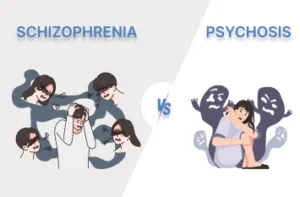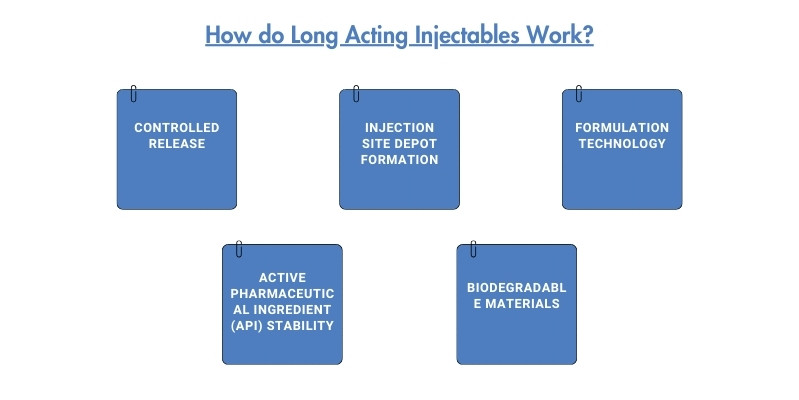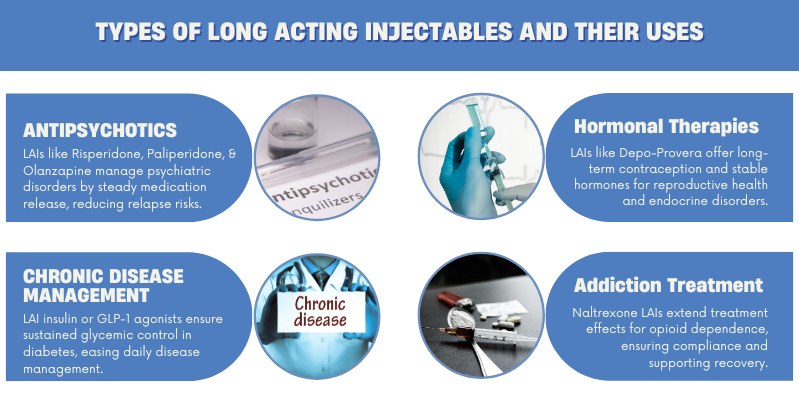
Schizophrenia VS Psychosis: How They are Different
Schizophrenia VS Psychosis: How They are Different Get Instant Relief Now! Schizophrenia and psychosis frequently stir up confusion and concern, yet they represent very different

Long Acting Injectables (LAIs) are a type of medication designed to release drugs into the bloodstream over an extended period, typically ranging from weeks to months, after a single injection. This innovative approach to medication delivery is particularly beneficial for managing chronic conditions, ensuring consistent therapeutic levels of medication without the need for daily dosing.
The FDA’s approval of various LAIs, particularly in the field of psychiatry for the treatment of conditions such as schizophrenia and bipolar disorder, underscores their significance. By offering a reliable and sustained release mechanism, LAIs enhance patient adherence to treatment regimens, reduce the frequency of dosing, and may lead to better overall therapeutic outcomes.
This approval by the FDA not only validates the effectiveness and safety of LAIs but also represents a significant step forward in the development of treatments that can improve the quality of life for individuals with chronic illnesses.
Long Acting Injectables (LAIs) are advanced pharmaceutical formulations that allow for the slow and steady release of medication into the bloodstream over extended periods, ranging from a few weeks to several months, after being administered through a single injection. This technology primarily aims to improve medication adherence, a common challenge in managing chronic conditions, by eliminating the need for daily dosing.
LAIs have found significant application in the treatment of mental health conditions, such as schizophrenia and bipolar disorder, where consistent medication levels are crucial for effective management.
By providing a more stable and consistent drug release, LAIs help to maintain therapeutic drug levels in the body, potentially reducing side effects and improving patient outcomes. The development and use of LAIs mark a significant advancement in medication delivery systems, offering patients a more convenient and effective option for long-term therapy management.
Long Acting Injectables (LAIs) operate through a carefully designed mechanism that allows for the gradual release of medication into the body, ensuring a consistent therapeutic effect over an extended period. This innovative approach significantly enhances treatment adherence and efficiency, particularly for chronic conditions requiring long-term management.

Controlled Release: LAIs are formulated to slowly release the medication into the bloodstream, ensuring a steady level of the drug is maintained over weeks or months.
Injection Site Depot Formation: Upon injection, typically into muscle tissue, the LAI forms a depot (a small storage area) from which the medication is gradually absorbed into the bloodstream.
Formulation Technology: LAIs can be formulated using various technologies, such as polymer-based systems, oil-based solutions, or crystalline suspensions, each designed to control the drug release rate.
Active Pharmaceutical Ingredient (API) Stability: The API in LAIs is stabilized in a way that allows it to remain effective over a long period, ensuring the medication’s therapeutic efficacy is maintained until the next dose.
Biodegradable Materials: Some LAIs are made with biodegradable materials that naturally dissolve in the body, eliminating the need for removal and reducing the risk of long-term tissue irritation.
Through these mechanisms, LAIs provide a reliable and convenient treatment option, reducing the frequency of dosing and potentially improving patient outcomes by ensuring more consistent drug levels in the body.
Long Acting Injectables (LAIs) offer a range of advantages that make them a compelling choice for both patients and healthcare providers, particularly in the management of chronic conditions. These benefits stem from their unique delivery mechanism and formulation, which together ensure a more consistent and controlled medication release.
Here are some of the key advantages:
Improved Adherence: The need for less frequent dosing reduces the burden on patients to remember daily medications, significantly improving treatment adherence.
Stable Drug Levels: LAIs maintain steady therapeutic drug levels in the bloodstream, reducing the peaks and troughs associated with oral medications and enhancing overall treatment efficacy.
Reduced Side Effects: By avoiding high peaks in drug concentration, LAIs can potentially minimize the side effects commonly associated with higher doses of oral medications.
Convenience: With dosing intervals ranging from weeks to months, LAIs offer greater convenience and can reduce the frequency of healthcare visits for medication administration.
Better Outcomes: The consistent drug levels achieved with LAIs can lead to better disease management, fewer hospitalizations, and improved quality of life for patients with chronic conditions.
Long Acting Injectables (LAIs) distinguish themselves from other medication forms through their unique delivery system and prolonged efficacy, offering significant advantages in the management of chronic diseases. Unlike daily oral medications that require strict adherence to dosing schedules,
LAIs are administered via injection, releasing medication slowly over time to maintain stable drug levels. This method not only simplifies treatment regimens but also minimizes the risk of non-adherence, a common issue with traditional medications. Additionally, LAIs can provide more consistent therapeutic effects, reducing the frequency of dose-related side effects.
| Feature | Long Acting Injectables (LAI) | Oral Medications | Short-acting Injectables |
| Dosing Frequency | Weeks to months | Daily, sometimes multiple times a day | Hours to days |
| Administration | Injection by healthcare professional | Self-administered | Injection by healthcare professional or self |
| Drug Release | Slow and steady | Rapid, with peaks and troughs | Immediate, with rapid decline |
| Adherence | Improved due to less frequent dosing | May be challenging due to frequent dosing | Varies, frequent dosing can be challenging |
| Convenience | Less frequent healthcare visits | Requires daily attention | Regular healthcare visits required |
| Steady Drug Levels | More consistent, reducing side effects | Less consistent, potential for more side effects | Less consistent, potential for rapid decline in effect |
The science behind Long Acting Injectables (LAI) centers on their design to achieve sustained drug release, thus maintaining therapeutic drug levels in the body over extended periods. This is achieved through advanced pharmaceutical formulations such as polymer-based systems, oil-based solutions, or crystalline suspensions, which encapsulate the active pharmaceutical ingredient (API) and control its release rate.
The mechanism of action involves the injection of the formulation into muscle or subcutaneous tissue, where it forms a depot that slowly releases the medication into the bloodstream. This controlled release minimizes the peaks and troughs associated with conventional dosing, reducing potential side effects while ensuring the efficacy of the medication over time.
The development of LAIs reflects a blend of chemical engineering, pharmacology, and material science, aiming to improve patient adherence and outcomes in the management of chronic conditions.
Long Acting Injectables (LAIs) come in various types, each tailored to address specific medical conditions through their unique formulation and mechanism of action. These injectables have revolutionized treatment paradigms across a range of diseases, offering extended medication release periods that enhance patient adherence and improve overall outcomes.

1.Antipsychotics:
LAIs such as Risperidone, Paliperidone, and Olanzapine are widely used in the management of psychiatric disorders, including schizophrenia and bipolar disorder. By providing a steady release of medication, these LAIs help in managing symptoms over time, reducing the risk of relapse.
2.Hormonal Therapies:
In the realm of reproductive health, LAIs like Depo-Provera (Medroxyprogesterone Acetate) offer long-term contraception. Similarly, hormone therapies for endocrine disorders, including certain forms of cancer, utilize LAIs to deliver consistent hormonal levels.
3.Chronic Disease Management:
For conditions like diabetes, LAI formulations of insulin or GLP-1 receptor agonists provide sustained glycemic control. This helps in minimizing the daily burden of disease management on patients.
4.Addiction Treatment:
LAIs such as Naltrexone for opioid dependence offer a way to ensure compliance and support recovery by extending the effects of treatment over weeks, which is crucial for maintaining sobriety.
Long Acting Injectables (LAIs) offer a groundbreaking approach in the treatment and management of various mental health conditions. These medications are particularly beneficial for individuals requiring consistent medication levels to manage their symptoms effectively, ensuring better adherence and minimizing the risk of relapse.
The use of LAIs spans across a range of psychiatric disorders, including schizophrenia, schizoaffective disorder, bipolar disorder, severe depression, anxiety disorders, and personality disorders.
In the management of schizophrenia, LAIs play a crucial role by providing stable medication levels, which are essential for controlling symptoms such as hallucinations, delusions, and thought disorders. Commonly used LAIs for schizophrenia include Risperidone (Risperdal Consta), Paliperidone (Invega Sustenna/Trinza), and Olanzapine (Zyprexa Relprevv).
These medications help in reducing the frequency of acute psychotic episodes and hospitalizations, thereby improving the quality of life for individuals living with schizophrenia.
For individuals with schizoaffective disorder, LAIs offer a dual benefit by managing both psychotic symptoms and mood disturbances. The consistent drug release from LAIs can help in stabilizing mood swings and reducing psychotic episodes, providing a more balanced approach to treatment.
Specific LAIs used in the treatment of schizoaffective disorder include Aripiprazole (Abilify Maintena) and Paliperidone (Invega Sustenna/Trinza), which have been effective in managing the complex symptoms of this condition.
Bipolar Disorder: LAIs such as Aripiprazole (Abilify Maintena) can be instrumental in stabilizing mood fluctuations and preventing both manic and depressive episodes in individuals with bipolar disorder. They offer a reliable option for long-term mood stabilization.
Severe Depression: For individuals with treatment-resistant depression, certain LAIs offer a new avenue for treatment. Although less common than in other disorders, the exploration of LAIs in severe depression is ongoing, with potential for future applications.
Anxiety Disorders: While the use of LAIs in treating anxiety disorders is not as prevalent, there is potential for their use in managing severe, treatment-resistant cases where consistent medication levels could improve overall functioning.
Personality Disorders: The application of LAIs in treating personality disorders is an area of interest, particularly in managing symptoms such as impulsivity or aggression in disorders like borderline personality disorder.
Choosing Long Acting Injectables (LAIs) as a treatment option involves careful consideration of several key factors to ensure that they align with the patient’s specific needs and treatment goals. Below are important factors to consider before opting for LAIs:
Condition Severity and Stability: LAIs are often recommended for managing chronic or severe conditions requiring consistent medication levels. Assessing the severity and stability of the condition is crucial to determine if LAIs are a suitable option.
Medication Adherence: For patients who struggle with adherence to daily medication regimens, LAIs offer an effective solution by reducing the frequency of dosing, thereby improving compliance and overall treatment outcomes.
Patient Lifestyle and Preferences: Considering the patient’s lifestyle, preferences, and their ability to attend regular appointments for injections is important. LAIs require administration by a healthcare professional at scheduled intervals.
Previous Treatment Response: The patient’s response to previous treatments, including oral medications, should be evaluated. A history of positive response to a particular medication available in LAI form could favor its selection.
Potential Side Effects: While LAIs can reduce the risk of certain side effects by providing steady medication levels, discussing potential side effects specific to the LAI formulation is essential to make an informed decision.
Cost and Insurance Coverage: LAIs can be more expensive than their oral counterparts. It’s important to consider the cost and insurance coverage to ensure the treatment is financially sustainable for the patient.
Healthcare Provider’s Expertise: The experience and expertise of the healthcare provider in administering LAIs and managing potential side effects should also be considered to ensure optimal care.
Long-term Treatment Goals: Aligning the choice of LAIs with the patient’s long-term treatment goals, including symptom management, quality of life improvement, and minimizing hospitalizations, is key to a successful treatment plan.
When comparing Long Acting Injectables (LAIs) to oral medications, it’s important to understand their distinct characteristics and how they can impact treatment outcomes. LAIs offer the advantage of sustained drug release, improving adherence and providing stable medication levels over time.
Conversely, oral medications require daily intake, which can be challenging for some patients to maintain, yet they offer flexibility and ease of dose adjustment.
| Feature | Long Acting Injectables (LAI) | Oral Medications |
| Administration | Administered by healthcare professionals at intervals (e.g., weeks or months) | Self-administered daily |
| Adherence | High, due to less frequent dosing | Can be variable, depending on patient’s ability to maintain daily regimen |
| Drug Release | Slow and steady, ensuring consistent therapeutic levels | Rapid absorption with potential for fluctuating levels |
| Flexibility | Dose adjustments require healthcare provider intervention | Easily adjusted by the patient or provider |
| Side Effects | Potential for long-term side effects that must be carefully managed | Easier to manage or adjust dosage to mitigate side effects |
| Cost | Potentially higher upfront costs but may be offset by reduced need for frequent dosing | Generally lower initial cost, but adherence issues can increase overall treatment cost |
This comparison highlights the importance of individualizing treatment plans based on patient needs, preferences, and specific medical conditions, ensuring the chosen method aligns with the patient’s lifestyle and treatment goals.
Long Acting Injectables (LAIs) offer a transformative approach to the management of various chronic conditions, particularly within the realm of mental health. Their unique mechanism of sustained drug release not only enhances treatment adherence but also ensures consistent therapeutic levels, thereby improving patient outcomes. The choice between LAIs and oral medications should be tailored to individual patient needs, taking into account factors such as condition severity, lifestyle, and treatment goals.
Title: Long-Acting Injectables (LAIs)
Written and Published By: NAMI (National Alliance on Mental Illness)
Title: Long-Acting Injectable Antipsychotics: A Systematic Review of Their Non-Systemic Adverse Effect Profile
Link: https://www.ncbi.nlm.nih.gov/pmc/articles/PMC8214363/
Written & Published By: National Library of Medicine / NIH.Org
Title: Psychiatric Pharmacy Essentials: Long-acting Injectable Antipsychotics
Link: https://aapp.org/guideline/essentials/lai
Written & Published By: American Association of Psychiatric Pharmacists (AAPP)

Schizophrenia VS Psychosis: How They are Different Get Instant Relief Now! Schizophrenia and psychosis frequently stir up confusion and concern, yet they represent very different

What is Bipolar Anger? Reasons Behind Bipolar Rage Get Instant Relief Now! Bipolar rage is a distinctive manifestation of bipolar disorder which is a mental

Who Can Prescribe Medication for Mental Health? In mental health treatment, the prescription of medication plays a pivotal role in alleviating symptoms, managing conditions, and
